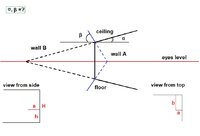Hello!
I've been extensively searching in the internet and have not found the answer to this (as I thought) simple question.
Was I wrong and the question is not simple at all, and if so why?
I am sitting in a room against the corner of two walls: wall A and wall B, and I am closer to wall A (see attached file).
I am drawing the corner: vertical line, two lines of the floor that cross somewhere with the vertical line and two lines of the ceiling that also cross the vertical line somewhat higher.
I know my distance from each of the walls and I know the height of the room and I know the distance from my eyes to the floor.
How do I calculate the angles Alpha and Beta between the lines on my drawing?
Kind regards,
Leo
I've been extensively searching in the internet and have not found the answer to this (as I thought) simple question.
Was I wrong and the question is not simple at all, and if so why?
I am sitting in a room against the corner of two walls: wall A and wall B, and I am closer to wall A (see attached file).
I am drawing the corner: vertical line, two lines of the floor that cross somewhere with the vertical line and two lines of the ceiling that also cross the vertical line somewhat higher.
I know my distance from each of the walls and I know the height of the room and I know the distance from my eyes to the floor.
How do I calculate the angles Alpha and Beta between the lines on my drawing?
Kind regards,
Leo

